Model Free Predictive Current Control Based on a Grey Wolf Optimizer for Synchronous Reluctance Motors
Abstract
:1. Introduction
2. Model Based Predictive Control
3. Model Free Predictive Current Control
3.1. Proposed GW-MFPCC
3.2. Grey Wolf Optimizer
4. Simulation and Experimental Results
4.1. Tuning and Computational Efforts
4.2. Control Performance
5. Conclusions
Author Contributions
Funding
Conflicts of Interest
Abbreviations and Symbols
| MBPCC | Model Based Predictive Current Control |
| SynRM | Synchronous Reluctance Motor |
| MFPCC | Model Free Predictive Current Control |
| GWO | Grey Wolf Optimizer |
| GW-MFPCC | Grey Wolf Optimizer Based Model Free Predictive Current Control |
| vdq | The Voltages in the dq- axes |
| idq | The Currents in the dq-axes |
| Rs | The stator resistance |
| Ld, Lq | The d-axis and q-axis inductances |
| ωe | The electrical rotor speed |
| ∆ | The variation values of the parameters |
| Ts | The sampling interval |
| g | The Cost Function |
| id*,iq* | The reference Currens of the dq axes |
| MTPA | The maximum torque per ampere |
| Xopt | The Optimum Input Factor |
| α, β, δ and ω | Wolves Groupes |
| Ng | The number of grey wolves |
| Mi | The maximum number of iterations |
| The distance between the grey wolf and the prey | |
| and | The Control Coefficient |
| The Position Vector of the search Agent | |
| The Prey | |
| n | Actual iteration number |
Appendix A
| Parameter | Value |
|---|---|
| Mi | 4 |
| Lb | 0 |
| Ub | 10 |
| Ng | 4 |
References
- Fratta, A.; Vagati, A. A reluctance motor drive for high dynamic performance application. IEEE Trans. Ind. Appl. 1992, 28, 873–879. [Google Scholar] [CrossRef]
- Matsuo, T.; Lipo, T. Rotor design optimization of synchronous reluctance machine. IEEE Trans. Energy Convers. 1994, 9, 359–365. [Google Scholar] [CrossRef]
- Vazquez, S.; Rodriguez, J.; Rivera, M.; Franquelo, L.G.; Norambuena, M. Model Predictive Control for Power Converters and Drives: Advances and Trends. IEEE Trans. Ind. Electron. 2017, 64, 935–947. [Google Scholar] [CrossRef] [Green Version]
- Cortes, P.; Kazmierkowski, M.P.; Kennel, R.M.; Quevedo, D.E.; Rodriguez, J. Predictive Control in Power Electronics and Drives. IEEE Trans. Ind. Electron. 2008, 55, 4312–4324. [Google Scholar] [CrossRef]
- Jlassi, I.; Cardoso, A.J.M. Enhanced and Computationally Efficient Model Predictive Flux and Power Control of PMSG Drives for Wind Turbine Applications. IEEE Trans. Ind. Electron. 2021, 68, 6574–6583. [Google Scholar] [CrossRef]
- Jlassi, I.; Cardoso, A.J.M. Lookup-Table-Based Model Predictive Torque Control Without Weighting Factors for PMSM Drives. In Proceedings of the IECON 2019—45th Annual Conference of the IEEE Industrial Electronics Society, Lisbon, Portugal, 14–17 October 2019; Volume 1, pp. 1165–1170. [Google Scholar] [CrossRef]
- Jlassi, I.; Cardoso, A.J.M. Open-circuit fault-tolerant operation of permanent magnet synchronous generator drives for wind turbine systems using a computationally efficient model predictive current control. IET Electr. Power Appl. 2021, 15, 837–846. [Google Scholar] [CrossRef]
- Gmati, B.; Jlassi, I.; El Khil, S.K.; Cardoso, A.J.M. Open-switch fault diagnosis in voltage source inverters of PMSM drives using predictive current errors and fuzzy logic approach. IET Power Electron. 2021, 14, 1059–1072. [Google Scholar] [CrossRef]
- Lubin, T.; Razik, H.; Rezzoug, A. Magnetic saturation effects on the control of a synchronous reluctance machine. IEEE Trans. Energy Convers. 2002, 17, 356–362. [Google Scholar] [CrossRef] [Green Version]
- Young, H.A.; Perez, M.A.; Rodriguez, J. Analysis of Finite-Control-Set Model Predictive Current Control with Model Parameter Mismatch in a Three-Phase Inverter. IEEE Trans. Ind. Electron. 2016, 63, 3100–3107. [Google Scholar] [CrossRef]
- Morales-Caporal, R.; Pacas, M. Suppression of Saturation Effects in a Sensorless Predictive Controlled Synchronous Reluctance Machine Based on Voltage Space Phasor Injections. IEEE Trans. Ind. Electron. 2010, 58, 2809–2817. [Google Scholar] [CrossRef]
- Morales-Caporal, R.; Pacas, M. Encoderless Predictive Direct Torque Control for Synchronous Reluctance Machines at Very Low and Zero Speed. IEEE Trans. Ind. Electron. 2008, 55, 4408–4416. [Google Scholar] [CrossRef]
- Morales-Caporal, R.; Pacas, M. A Predictive Torque Control for the Synchronous Reluctance Machine Taking into Account the Magnetic Cross Saturation. IEEE Trans. Ind. Electron. 2007, 54, 1161–1167. [Google Scholar] [CrossRef]
- Jlassi, I.; Cardoso, A.J.M. Model Predictive Current Control of Synchronous Reluctance Motors, Including Saturation and Iron Losses. In Proceedings of the XIII International Conference on Electrical Machines (ICEM), Alexandroupoli, Greece, 3–6 September 2018; pp. 1598–1603. [Google Scholar]
- Lin, C.-K.; Liu, T.-H.; Yu, J.-T.; Fu, L.-C.; Hsiao, C.-F. Model-Free Predictive Current Control for Interior Permanent-Magnet Synchronous Motor Drives Based on Current Difference Detection Technique. IEEE Trans. Ind. Electron. 2013, 61, 667–681. [Google Scholar] [CrossRef]
- Lin, C.-K.; Yu, J.-T.; Lai, Y.-S.; Yu, H.-C. Improved Model-Free Predictive Current Control for Synchronous Reluctance Motor Drives. IEEE Trans. Ind. Electron. 2016, 63, 3942–3953. [Google Scholar] [CrossRef]
- Da Ru, D.; Polato, M.; Bolognani, S. Model-free predictive current control for a SynRM drive based on an effective update of measured current responses. In Proceedings of the 2017 IEEE International Symposium on Predictive Control of Electrical Drives and Power Electronics (PRECEDE), Pilsen, Czech Republic, 4–6 September 2017; pp. 119–124. [Google Scholar] [CrossRef]
- Carlet, P.G.; Tinazzi, F.; Bolognani, S.; Zigliotto, M. An Effective Model-Free Predictive Current Control for Synchronous Reluctance Motor Drives. IEEE Trans. Ind. Appl. 2019, 55, 3781–3790. [Google Scholar] [CrossRef] [Green Version]
- Ma, C.; Li, H.; Yao, X.; Zhang, Z.; De Belie, F. An Improved Model-Free Predictive Current Control with Advanced Current Gradient Updating Mechanism. IEEE Trans. Ind. Electron. 2020, 68, 11968–11979. [Google Scholar] [CrossRef]
- Xu, L.; Chen, G.; Li, Q. Ultra-Local Model-Free Predictive Current Control Based on Nonlinear Disturbance Compensation for Permanent Magnet Synchronous Motor. IEEE Access 2020, 8, 127690–127699. [Google Scholar] [CrossRef]
- Zhou, Y.; Li, H.; Liu, R.; Mao, J. Continuous Voltage Vector Model-Free Predictive Current Control of Surface Mounted Permanent Magnet Synchronous Motor. IEEE Trans. Energy Convers. 2018, 34, 899–908. [Google Scholar] [CrossRef]
- Zhang, Y.; Jiang, T.; Jiao, J. Model-Free Predictive Current Control of a DFIG Using an Ultra-Local Model for Grid Synchronization and Power Regulation. IEEE Trans. Energy Convers. 2020, 35, 2269–2280. [Google Scholar] [CrossRef]
- Zhang, Y.; Jin, J.; Huang, L. Model-Free Predictive Current Control of PMSM Drives Based on Extended State Observer Using Ultralocal Model. IEEE Trans. Ind. Electron. 2020, 68, 993–1003. [Google Scholar] [CrossRef]
- Zhang, Y.; Jiang, T.; Jiao, J. Model-Free Predictive Current Control of DFIG Based on an Extended State Observer Under Unbalanced and Distorted Grid. IEEE Trans. Power Electron. 2020, 35, 8130–8139. [Google Scholar] [CrossRef]
- De Martin, I.D.; Pasqualotto, D.; Tinazzi, F.; Zigliotto, M. Model-Free Predictive Current Control of Synchronous Reluctance Motor Drives for Pump Applications. Machines 2021, 9, 217. [Google Scholar] [CrossRef]
- Tinazzi, F.; Carlet, P.G.; Bolognani, S.; Zigliotto, M. Motor Parameter-Free Predictive Current Control of Synchronous Motors by Recursive Least-Square Self-Commissioning Model. IEEE Trans. Ind. Electron. 2019, 67, 9093–9100. [Google Scholar] [CrossRef]
- Saeed, M.S.; Song, W.; Yu, B. Robustness Improvement of Deadbeat Model Predictive Control for Five-phase PMSM Drives. In Proceedings of the 2020 15th IEEE Conference on Industrial Electronics and Applications (ICIEA), Kristiansand, Norway, 9–13 November 2020; IEEE: Piscataway, NJ, USA, 2020. [Google Scholar]
- Mirjalili, S.; Mirjalili, S.M.; Lewis, A. Grey Wolf Optimizer. Adv. Eng. Softw. 2014, 69, 46–61. [Google Scholar] [CrossRef] [Green Version]
- Qais, M.H.; Hasanien, H.M.; Alghuwainem, S. A Grey Wolf Optimizer for Optimum Parameters of Multiple PI Controllers of a Grid-Connected PMSG Driven by Variable Speed Wind Turbine. IEEE Access 2018, 6, 44120–44128. [Google Scholar] [CrossRef]
- Sun, X.; Jin, Z.; Cai, Y.; Yang, Z.; Chen, L. Grey Wolf Optimization Algorithm Based State Feedback Control for a Bearingless Permanent Magnet Synchronous Machine. IEEE Trans. Power Electron. 2020, 35, 13631–13640. [Google Scholar] [CrossRef]
- Sun, X.; Hu, C.; Lei, G.; Guo, Y.; Zhu, J. State Feedback Control for a PM Hub Motor Based on Gray Wolf Optimization Algorithm. IEEE Trans. Power Electron. 2019, 35, 1136–1146. [Google Scholar] [CrossRef]
- Djerioui, A.; Houari, A.; Ait-Ahmed, M.; Benkhoris, M.-F.; Chouder, A.; Machmoum, M. Grey Wolf based control for speed ripple reduction at low speed operation of PMSM drives. ISA Trans. 2018, 74, 111–119. [Google Scholar] [CrossRef]
- Cortes, P.; Rodriguez, J.; Silva, C.; Flores, A. Delay Compensation in Model Predictive Current Control of a Three-Phase Inverter. IEEE Trans. Ind. Electron. 2011, 59, 1323–1325. [Google Scholar] [CrossRef]
- Matos, D.; Estima, J.O.; Yahia, K.; Cardoso, A.J.M. Modeling and Implementation of MTPA Control Strategy for SynRM Variable Speed Drives. Int. Rev. Electr. Eng. (IREE) 2014, 9, 1103. [Google Scholar] [CrossRef]
- Yahia, K.; Matos, D.; Estima, J.O.; Cardoso, A.J.M. Modeling synchronous reluctance motors including saturation, iron losses and mechanical losses. In Proceedings of the 2014 International Symposium on Power Electronics, Electrical Drives, Automation and Motion, Ischia, Italy, 18–20 June 2014; pp. 601–606. [Google Scholar]
- Cortes, P.; Rodríguez, J.; Quevedo, D.; Silva, C. Predictive Current Control Strategy with Imposed Load Current Spectrum. IEEE Trans. Power Electron. 2008, 23, 612–618. [Google Scholar] [CrossRef]
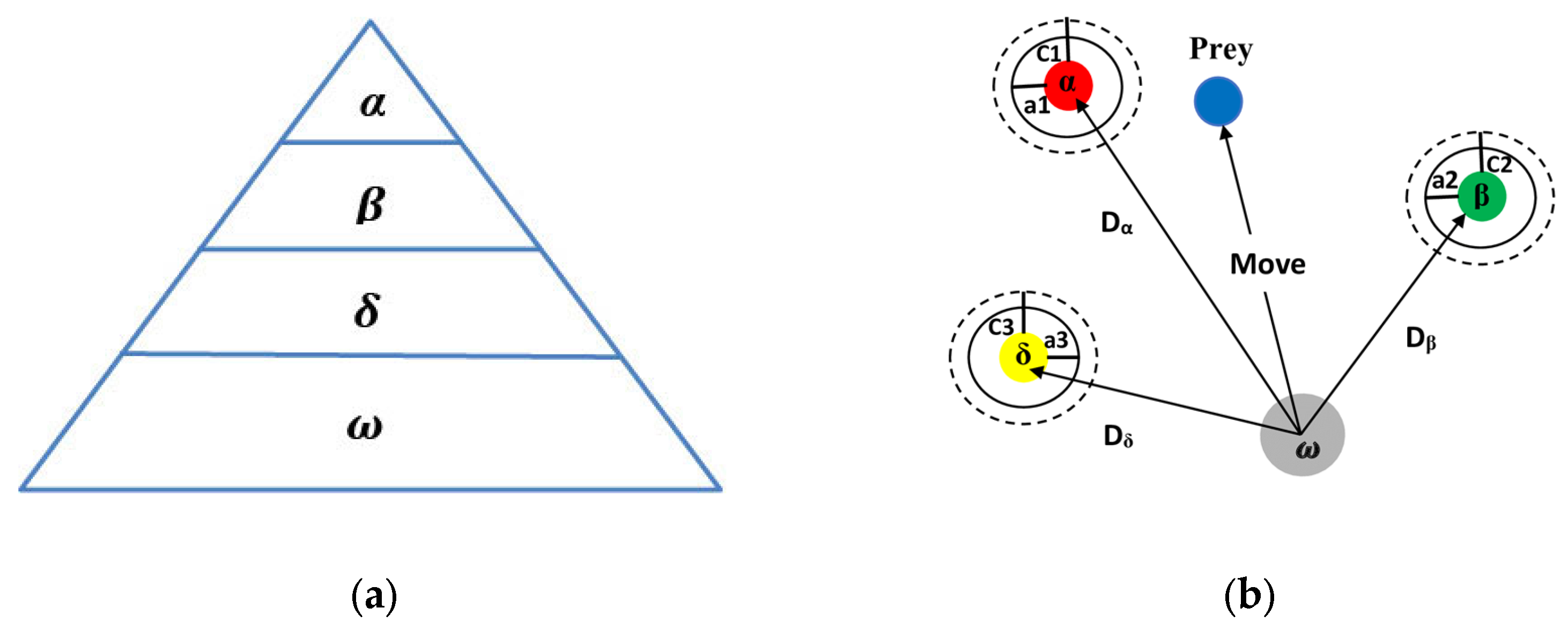
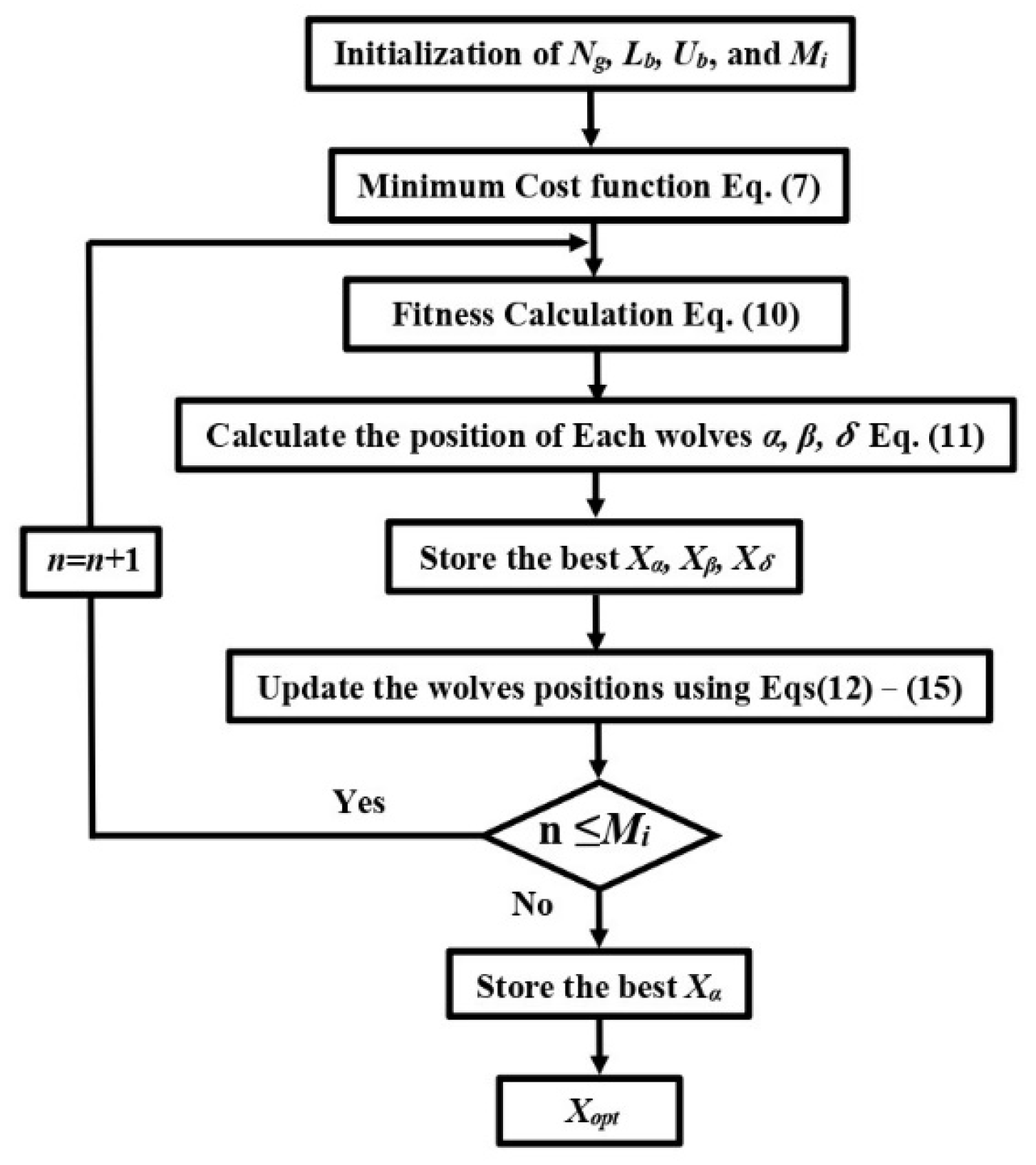
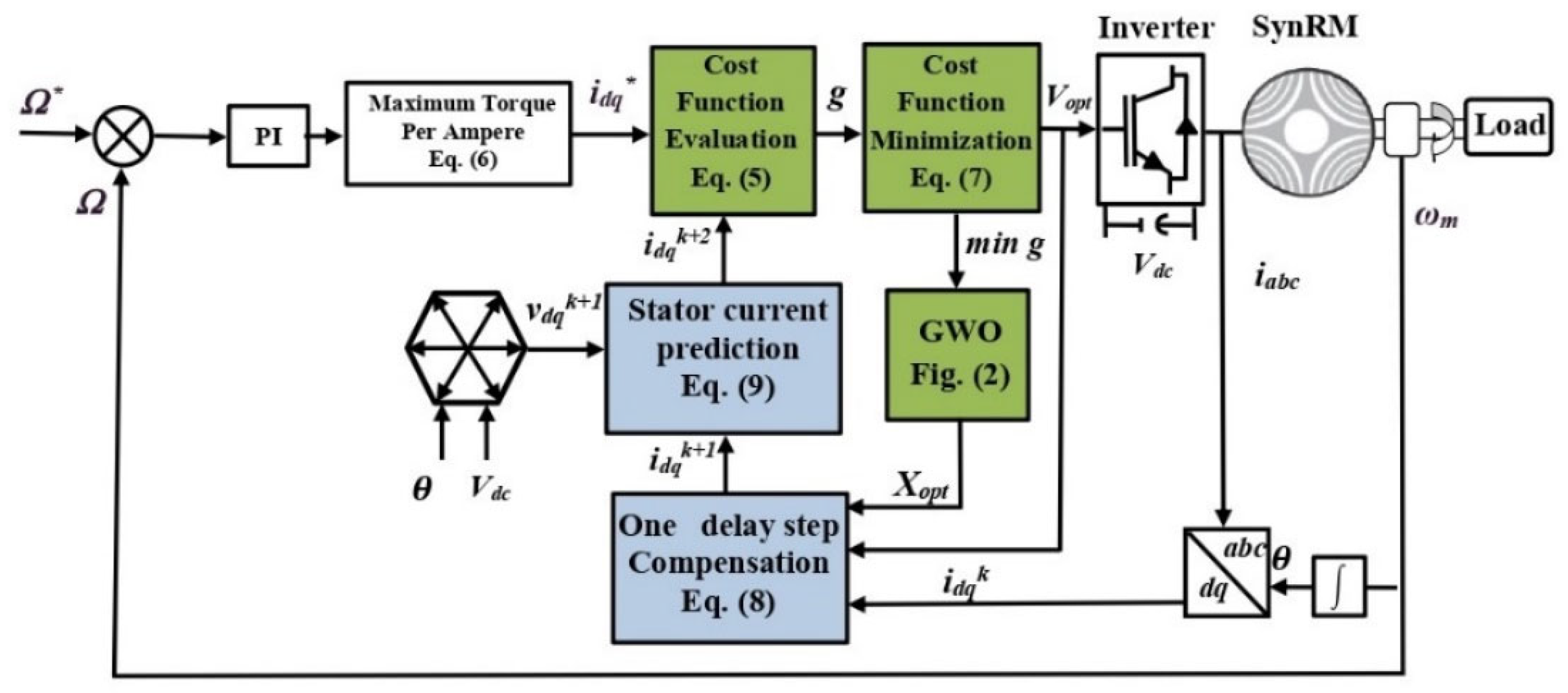
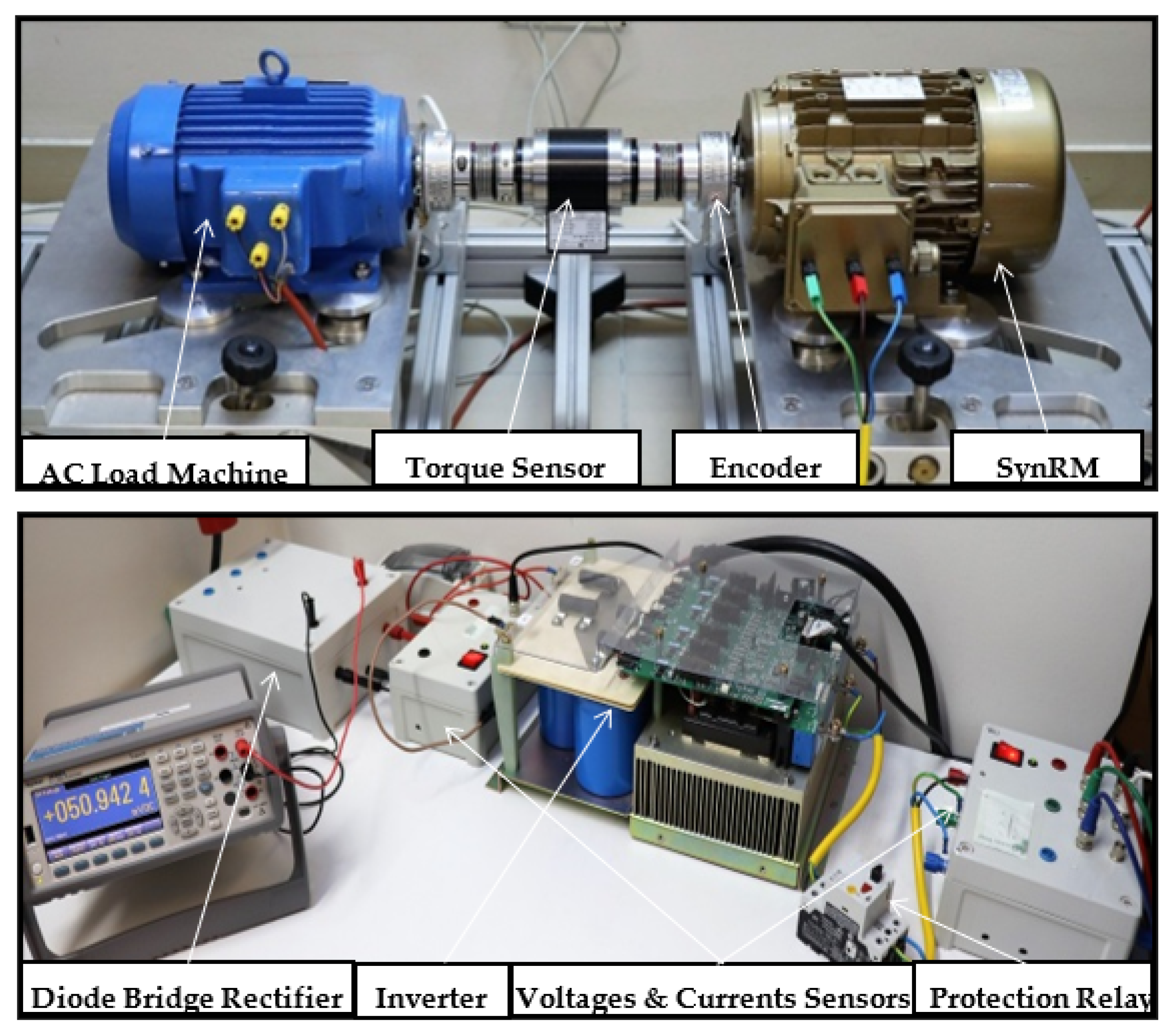

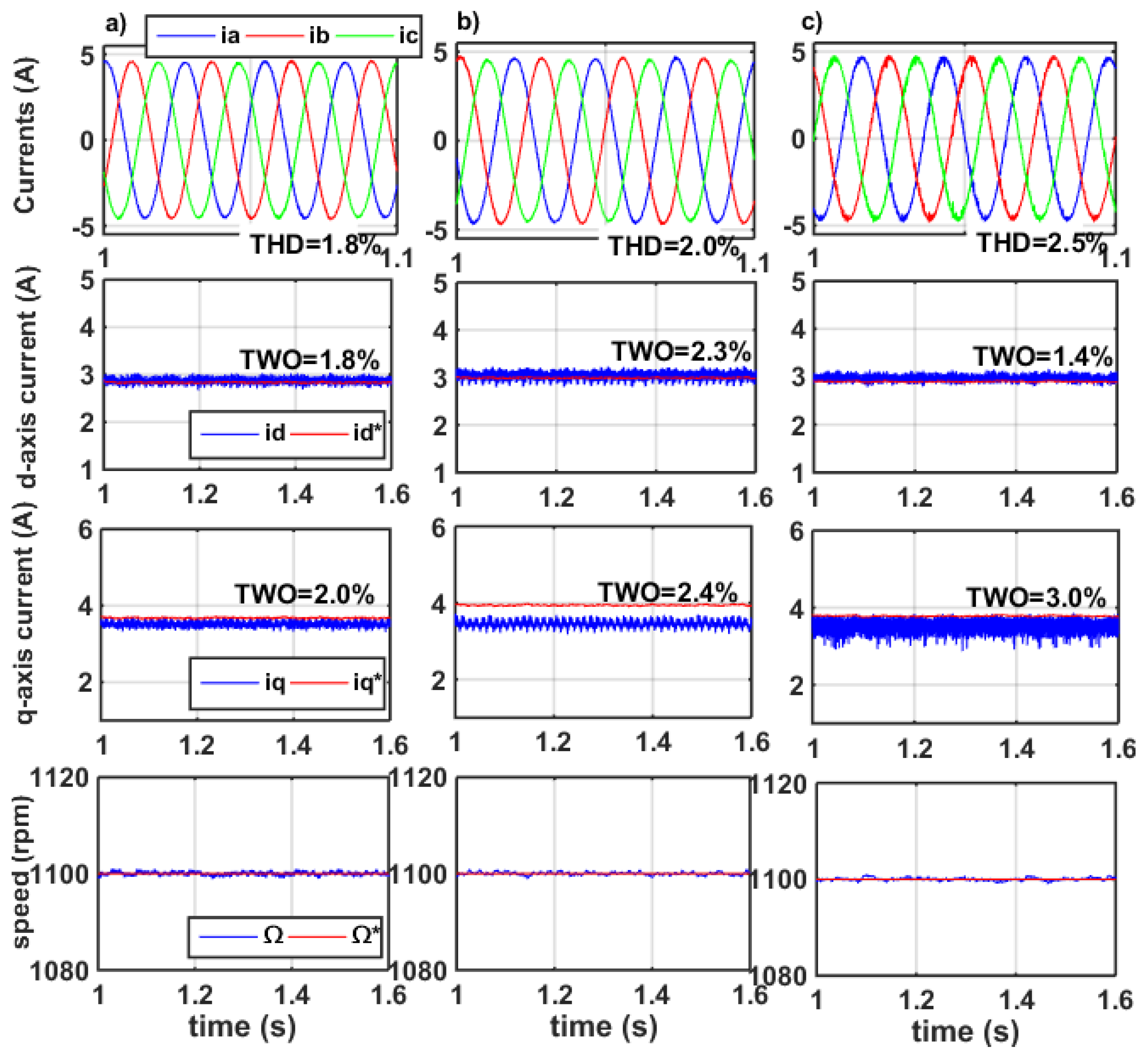
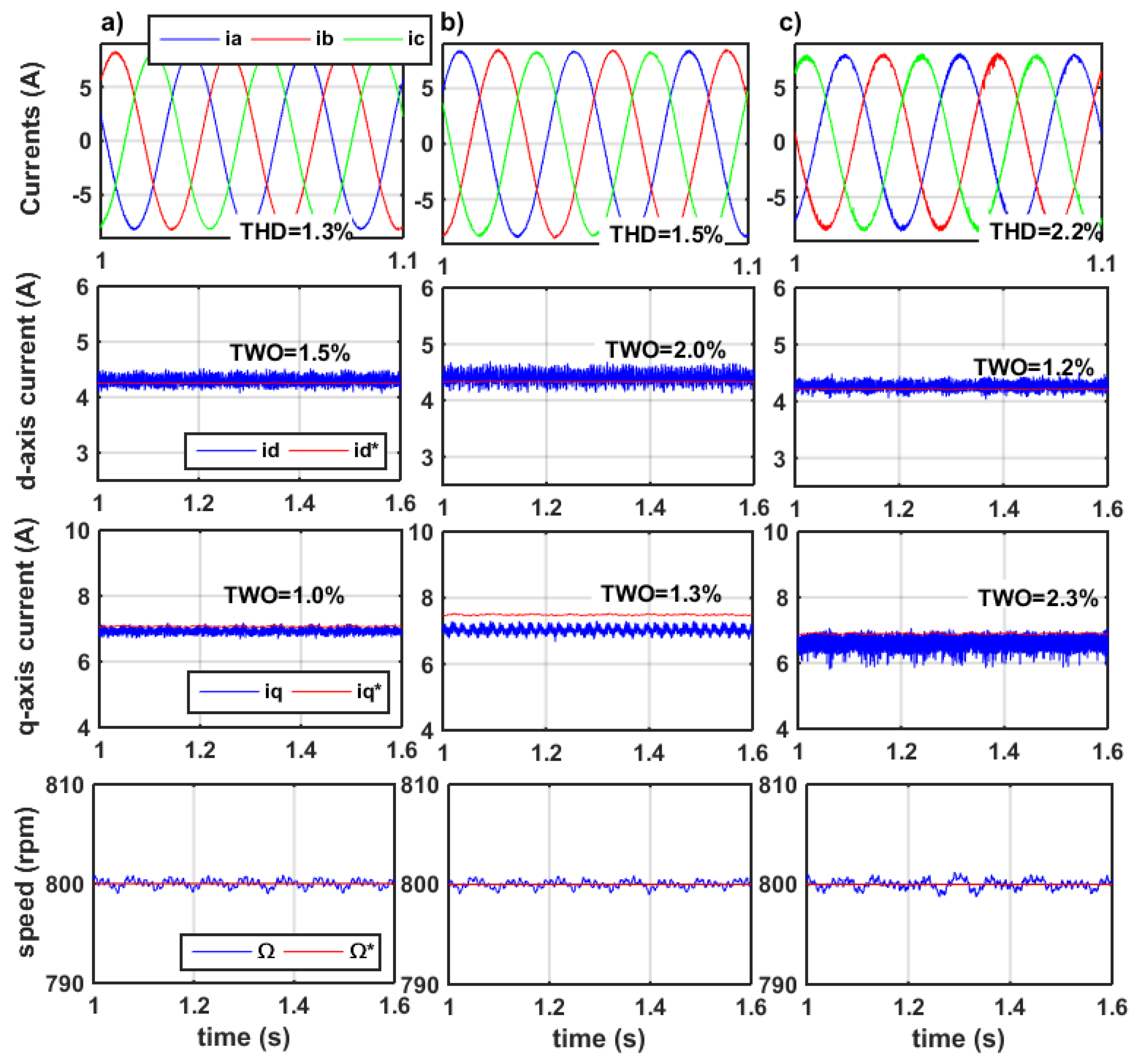
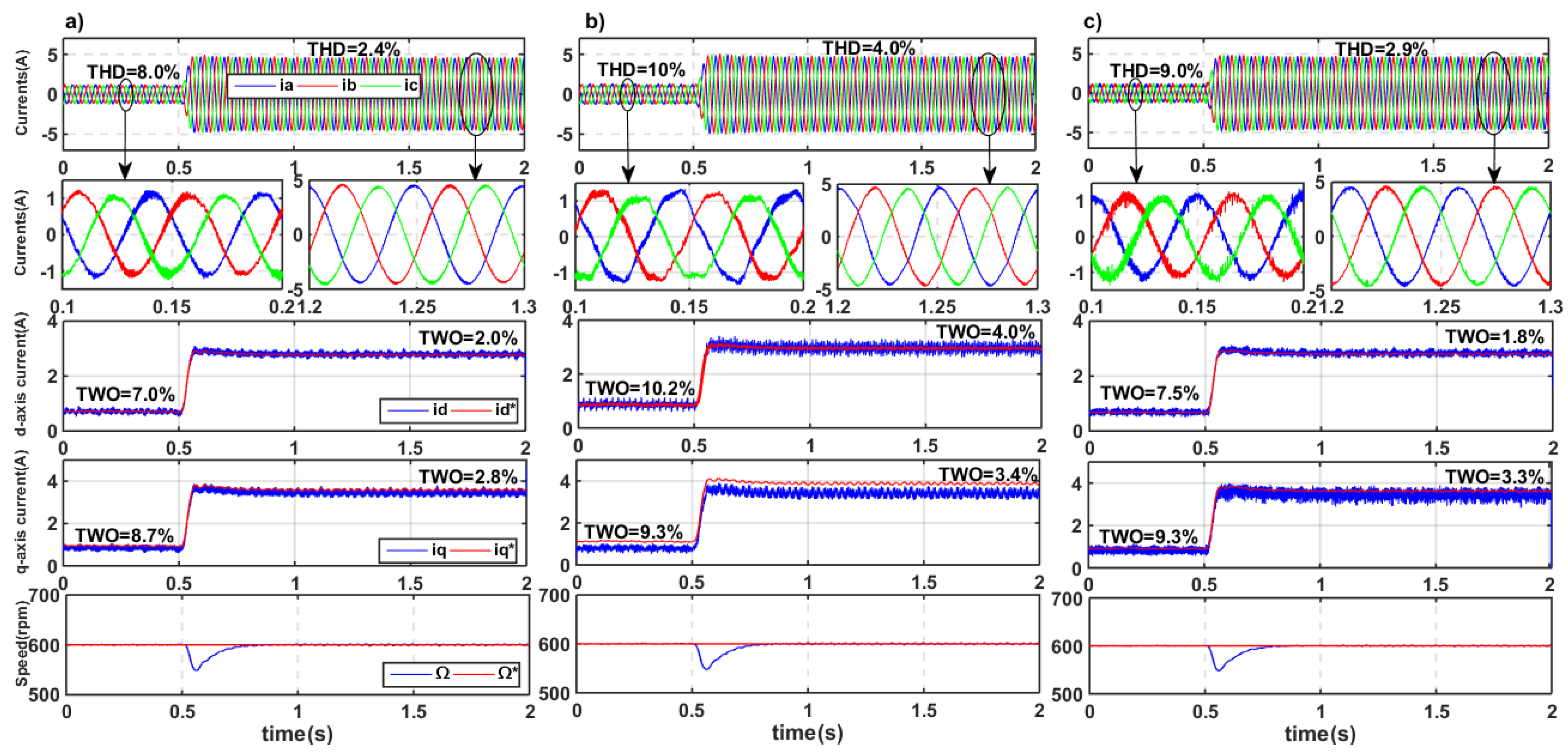

| Speed N | 1500 rpm |
| Voltage V | 366 V |
| Current I | 5.7 A |
| Torque TL | 14 N.m |
| Inductances Ld/Lq | 0.24/0.057 H |
| Stator resistance Rs | 1.72 Ω |
| MBPCC | GW-MFPCC | |
|---|---|---|
| Motor Parameters to be tuned | Rs, Ld, Lq, and So on | Null |
| GWO Parameters to be tuned | Null | Mi, Lb, Ub, Ng |
| ExecutionTime (µs) | 25.9 | 28.5 |
Publisher’s Note: MDPI stays neutral with regard to jurisdictional claims in published maps and institutional affiliations. |
© 2022 by the authors. Licensee MDPI, Basel, Switzerland. This article is an open access article distributed under the terms and conditions of the Creative Commons Attribution (CC BY) license (https://creativecommons.org/licenses/by/4.0/).
Share and Cite
Mahmoudi, A.; Jlassi, I.; Cardoso, A.J.M.; Yahia, K. Model Free Predictive Current Control Based on a Grey Wolf Optimizer for Synchronous Reluctance Motors. Electronics 2022, 11, 4166. https://doi.org/10.3390/electronics11244166
Mahmoudi A, Jlassi I, Cardoso AJM, Yahia K. Model Free Predictive Current Control Based on a Grey Wolf Optimizer for Synchronous Reluctance Motors. Electronics. 2022; 11(24):4166. https://doi.org/10.3390/electronics11244166
Chicago/Turabian StyleMahmoudi, Abdelkader, Imed Jlassi, Antonio J. Marques Cardoso, and Khaled Yahia. 2022. "Model Free Predictive Current Control Based on a Grey Wolf Optimizer for Synchronous Reluctance Motors" Electronics 11, no. 24: 4166. https://doi.org/10.3390/electronics11244166







